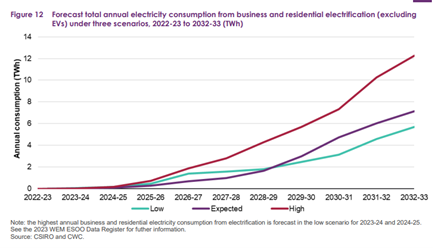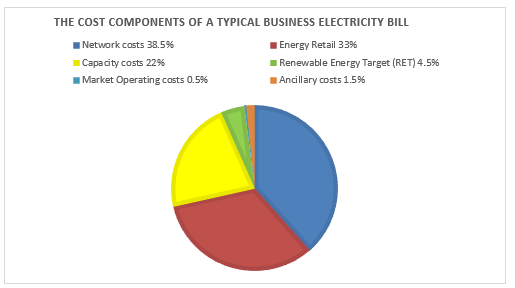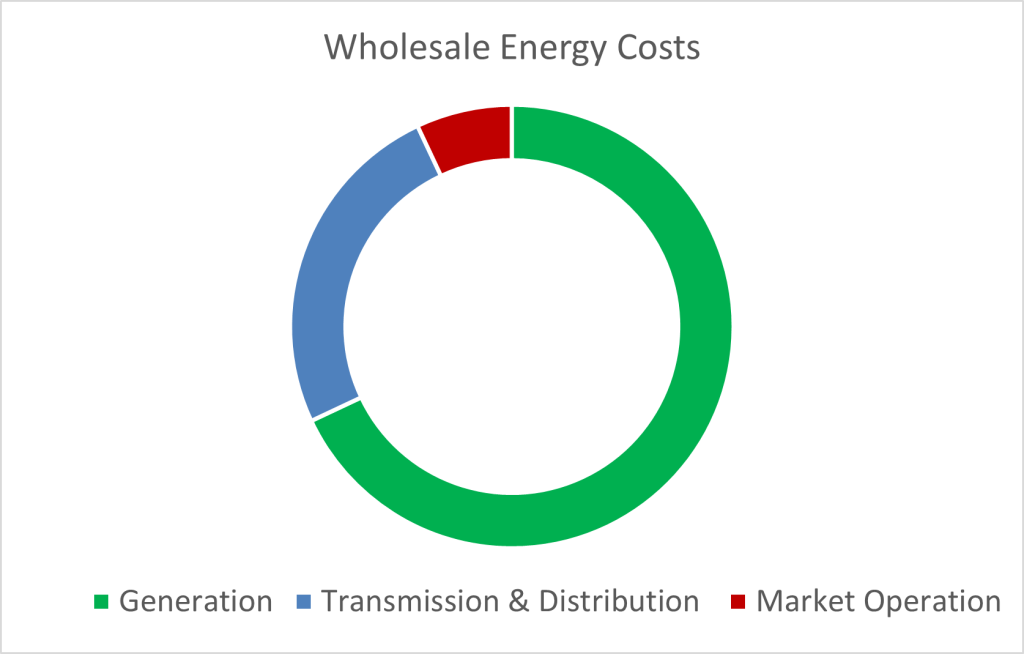Demystifying Business Electricity Pricing in Perth: What Factors Influence Costs?
Alex Koresis
Why Electricity Prices Are At Record Highs
Western Australian businesses are experiencing “bill shock” with business electricity rates in Perth rising to record highs, despite increases in renewable energy generation (1). Why is that? The simple answer is; it’s complicated!
The South West Interconnected System (SWIS) powers most households and businesses in Western Australia, but it’s isolated from the rest of Australia. Consequently, the SWIS grid must have the capacity to supply the maximum demand for every electricity consumer, even if it’s for just one minute on any given day.
It’s an expensive process for the Australian Energy Market Operator (AEMO) to manage capacity and deliver the maximum electricity load because every business has unique power requirements. For the SWIS grid, electricity supply must always meet demand to avoid power outages, additional expenditures and further price increases. In 2022, 100,000 tonnes of coal was imported from NSW to meet WA’s electricity demand, costing the state over $100 million (2).
In addition to demand, multiple factors influence business electricity prices and understanding these factors can help WA business owners manage their consumption to minimise the negative impact on their bottom line.
How Business Electricity Prices Are Calculated
A typical bundled electricity bill displays the amount of kilowatt hours (kWh) consumed, the applicable business electricity rates and the daily supply charge to arrive at the total amount payable. Most business electricity customers don’t know that bundled electricity rates comprise reducible charges that can be managed to effectively decrease costs.
In the chart below, the standard charges for a typical business are depicted showing each component used to calculate the overall cost. Approximately 33% of a standard bundled electricity bill is for actual energy use while the remaining 67% covers the wholesale supply costs including Network transmission and distribution (Western Power), capacity costs (AEMO), Renewable Energy Target (RET), retail market and administrative costs.
Consumers with a good understanding of business electricity can choose an unbundled tariff that separates each component to enable energy management and reduce electricity costs. A savvy business owner adopting renewable energy technologies and acting on energy management advice could save between 10% and 50% per annum.
Energy optimisation actions such as reducing grid consumption, improving energy efficiency, choosing the best Network tariff, managing demand and the time of electricity use, plus acting on energy management advice can achieve this.
(Created by Amanda Energy)
Factors Influencing Business Electricity Prices
Many factors influencing electricity prices in the SWIS grid are entangled and interdependent. The complexity increases when considering factors including:
- world events
- global fuel prices
- population growth
- commercial and industrial expansion
- weather
- climatic emergencies
- energy policy
- regulations that enable or inhibit renewable technologies
- inflation
- operational market conditions
- participation,
- and more!
As a result, the price of electricity in the Wholesale Energy Market (WEM) fluctuates throughout the day in 30-minute intervals in line with market forces and impacts consumer demand, generation and capacity.

Supply and Demand in the Market
In 2006, the WEM was created to facilitate the buying and selling of electricity between electricity generators and retailers in the SWIS (3). Electricity retailers buy electricity from three major sources:
- bilateral contracts direct with generators
- the Balancing Market (BM)
- the Short-Term Energy Market (STEM) (4).
The main objective of the WEM is to ensure reliable electricity supply to consumers at the lowest sustainable cost (5). Currently, 17 TW hours of electricity are generated and sold on the WEM (6). Deregulation has enabled more competitive pricing for contestable customers; that is business electricity customers consuming over 50,000 kWh per annum. But, with population and industrial growth, consumer demand for electricity has risen significantly. AEMO has forecasted electricity demand to increase by at least 5.7 TW hours and potentially up to 12.2 TW hours over the next 10 years, requiring 51.1 GW of new generation and capacity (7).
Electricity Generation and Distribution Costs
The maximum available power that can be supplied to the SWIS at any given time is dependent on the actual amount of power that can be generated. Electricity generated to supply the SWIS comes from various sources and the amount of electricity generated is determined by the production and performance of various fuel types (8).

In addition to generation costs, major costs influencing electricity prices include transmission and distribution plus market operating costs. Maintaining and upgrading the network infrastructure are costs payable to Western Power and regulated by the Economic Regulation Authority (ERA) which oversees the WEM and is influenced by Energy Policy Western Australia (EPWA). (9).
(Created by Amanda Energy)
The need to expand the SWIS grid and integrate more renewable energy for decarbonisation to meet increased electricity demand will require an estimated 4,000km of extra power lines, plus upgrades estimated to cost between $6.5 billion to $11.5 billion (10). A portion of network costs are passed through to electricity consumers through energy retailers who pay Western Power directly.
Market operating costs
Market operating costs are the management and operational costs of the WEM including the fees charged by AEMO, ERA, and EPWA for their roles and functions in the WEM (11). These are primarily determined by the market rules and procedures, reform and development activities and the cost of overseeing the market. Some of these costs are passed onto the energy consumer via the energy retailer who also incur retail operating costs by providing electricity services to customers.
Understanding Electricity Price Comparison
The best way to compare electricity plans and prices between energy retailers is for business owners to first understand their unique energy footprint. Knowing their consumption figures, peak and off-peak usage, maximum demand, and load profile is a great starting point towards reducing costs.
A business electricity bill should indicate when the business uses electricity throughout the day. This is called an electricity load profile. If a business consumes electricity between 4 pm and 10 pm on weekdays, they’re paying the highest electricity price. Why? Solar electricity is the cheapest form of electricity (12) resulting in very low power prices during the day. However, as solar production decreases towards the end of the day, demand for electricity increases as consumers go home and switch on appliances. This increased demand drives up electricity prices until around 10 pm, when off-peak prices come into effect.
The standard peak hours for business electricity is 8 am – 10 pm Monday to Friday. Standard off-peak hours are 10 pm – 8 am Monday to Friday and all weekend.
By managing when and how much electricity is being consumed, a business owner can impact their business electricity rates by consuming when power is the cheapest, and reducing demand when capacity is the lowest. Effectively, this can reduce contracted electricity rates for a business. Most electricity contracts are for a one or two-year supply term.
Given the current volatility in the electricity market, business owners and managers should be aware of:
- Contract Start and End date – some contracts automatically renew so put it in your calendar!
- Minimum Consumption Requirement – businesses can be charged penalties if the percentage annual consumption level is not reached.
- Early Termination Fees – trying to exit a current contract and switch providers could be costly. Check to see if your contract has any exit fees.
- Annual Contract Quantity – the minimum consumption is based on this figure and failure to meet this quantity may result in additional charges.
- Median Peak Load – this is your business electricity demand, measured in kilowatts during peak interval periods over the summer, usually between 4pm and 7pm when the grid is under pressure.
- CPI – are prices inclusive of CPI? Are they applicable quarterly or annually?
Reduce your business electricity prices, talk to an energy expert today.
Factors Contributing to Rising Electricity Prices
Inflation aside, the main reasons for higher electricity prices in Western Australia are attributed to:
- poor decarbonisation planning by the WA Government (13)
- shortages in the supply of coal and gas (14)
- higher electricity demand
- higher fuel costs
- lack of network infrastructure (15).
The table below indicates the average electricity price in the balancing market for each quarter in 2022 and 2023 (16).
|
Quarter |
2022 |
2023 |
|
Q1 |
$ 54.86/ MWh |
$ 74.41/ MWh |
|
Q2 |
$ 63.92/ MWh |
$ 102.09/ MWh |
|
Q3 |
$ 71.82/ MWh |
$ 88.96/ MWh |
|
Q4 |
$ 72.80/ MWh |
(Data extracted from AEMO)
Will Electricity Prices Go Down?
Due to its isolated grid, the Western Australian outlook is very different from the rest of Australia. While experts disagree on whether electricity prices will go up or down in the SWIS, business electricity rates in WA are currently the highest in Australia (17). And while wholesale costs have declined, the lag may be experienced well into 2024 given most electricity supply agreements are one or two years in duration.
While businesses wait for the lag of electricity supply and network issues to subside, talking to an energy expert could help alleviate some bill pain. Your business may benefit by investing in solar PV, battery energy storage systems (BESS) or participating in demand response programs to reduce load at times when the grid is under pressure.
Be A Proactive Business Electricity Consumer
As a business owner, you may not be able to influence the wholesale cost of business electricity, but you can affect your electricity prices by taking a more proactive approach to energy use and understanding the factors within your control. These include:
- How much electricity your business consumes
- When is the best time to consume electricity
- When is the best time to reduce consumption
Contractual terms and conditions are also important. Ultimately, communicating with their energy retailer to develop a tailored energy plan over the next supply term is the smartest and most effective way to reduce business electricity costs.
SOURCES
- AEMO | Renewables drive lower prices, record low emissions
- Western Australia’s energy future in turmoil – ABC News
- Wholesale Electricity Market (www.wa.gov.au)
- Electricity Prices WA: How Our Energy Crisis Affects Business Electricity (amandaenergy.com.au)
- -WEM.Rep.2022—Triennial-review-of-the-ale-Electricity-Market-2022—Report-to-the-Minister-for-Energy—Clean-version.PDF (erawa.com.au)
- AEMO Wholesale Electricity Market Fact Sheet
- 2023 Wholesale Electricity Market Statement of Opportunities (AEMO)
- Wholesale Electricity Market Fact Sheet (AEMO
- WA Government Business and Government Electricity Pricing
- SWIS Demand Assessment (www.wa.gov.au)
- Western Australia Wholesale Electricity Market 2022-23 AEMO Budget and Fees
- Microsoft Word – GenCost2021-22Final_20220708.docx (csiro.au)
- Strike Energy’s Stuart Nicholls warns WA headed for energy crisis after Perdaman fertiliser plant gets go-ahead (afr.com)
- Electricity Prices WA: How Our Energy Crisis Affects Business Electricity (amandaenergy.com.au)
- SWIS Demand Assessment (www.wa.gov.au)
- Market Data (aemo.com.au)
- Wholesale power prices tumble but experts warn little relief in sight for consumers – ABC News


